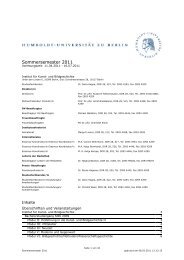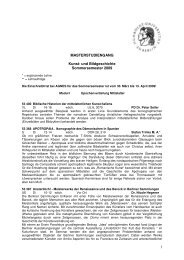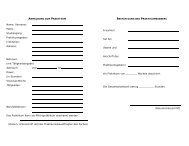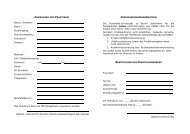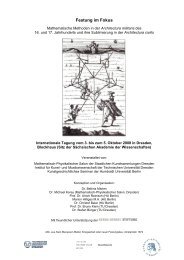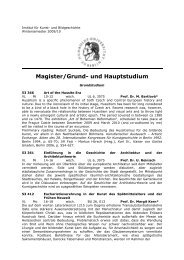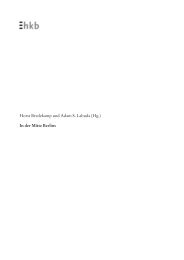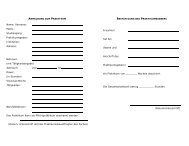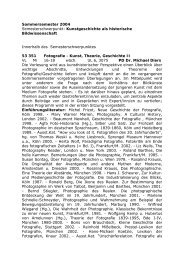Bauhaus Construct - Institut für Kunst
Bauhaus Construct - Institut für Kunst
Bauhaus Construct - Institut für Kunst
You also want an ePaper? Increase the reach of your titles
YUMPU automatically turns print PDFs into web optimized ePapers that Google loves.
The Irreproducibility of the <strong>Bauhaus</strong> Object<br />
have safeguarded their own, autonomous authority, grounded in tradition,<br />
and resisted being taken up and appropriated by the masses. However, a<br />
loss of aura and authority would necessarily have resulted if the <strong>Bauhaus</strong><br />
had succeeded in factory mass reproduction.<br />
These issues of production and reproduction of art, architecture,<br />
and objects were a subject of period concern among theorists and critics,<br />
such as Benjamin and the architectural critic Adolf Behne, artists such as<br />
Moholy-Nagy, and architects such as Gropius. 60 Each had different, specific<br />
ideas, but the terms and the overarching concern—the relationship of<br />
the authentic art object to the modern means of production—formed an<br />
important commonality of period discourse. In his 1917 essay, “The Reproductive<br />
Age” (Das reproduktive Zeitalter), Behne argued that, unlike with<br />
earlier authentic artworks, technological reproduction caused the essential<br />
effect—Wirkung—of the original to be lost, and yet the aesthetic values<br />
of the work of art were transferred to the reproductive process itself. 61<br />
Moholy-Nagy’s 1922 essay “Production-Reproduction” went further, specifying<br />
the goal of making reproductive processes useful for creative activities.<br />
62 Benjamin identified the loss of authenticity and aura and the turn to<br />
mass reproduction as inevitable consequences of the modern transformation<br />
in conditions of production, which nonetheless bore great artistic and<br />
political potential, while Moholy-Nagy, and the <strong>Bauhaus</strong> generally, actively<br />
endorsed mass reproduction as an art practice.<br />
Perhaps the <strong>Bauhaus</strong> should be assessed in terms not of production,<br />
but of reproduction—the stage at which it failed most visibly to<br />
realize its aims. 63 As Gropius shifted the emphasis of the <strong>Bauhaus</strong> towards<br />
mass reproduction, along with other basic operations he instituted, he<br />
was reacting not to a change in the availability of industrial technology, but<br />
rather to a change in ideas about process. In an attempt to broaden consumption,<br />
the <strong>Bauhaus</strong> needed to move from concentrating on production<br />
(where it arguably did well, generating many functionally and aesthetically<br />
successful designs in a relatively short period of time) to reproduction. As<br />
this examination has shown, reproduction, as both a practical process and<br />
a theoretical construct, is precisely where a material and economic failure<br />
took place; at the same time, theoretical signification can be read from this<br />
historical episode.<br />
In evaluating the <strong>Bauhaus</strong>, it is the emphasis laid on the process<br />
of reproduction that is important and imbued with social significance in<br />
the context of the period. As K. Michael Hays has pointed out, Benjamin’s<br />
analysis reveals that as one approaches those mediums that are inherently<br />
multiple and reproducible, not only does the authenticity of the object,<br />
its here and now, lose its value as a repository of meaning, but also the<br />
53



